If you are planning to get an aquarium then you may have come across the term “cycling a fish tank”.
But what does that mean?
Well, I’ve got a couple of aquariums. And I had “cycled” them before putting fish into it.
In this article, I’m going to tell you what cycling a fish tank or aquarium really means.
Cycling a fish tank means creating an automatic filtration cycle in the fish tank so the water in the fish tank can remain safe for the fish. There are two ways to cycle a fish tank – Fish-in cycling and Fishless cycling.
Cycling your new fish tank is the first and the most important step in creating a healthy environment for the fish in your aquarium so it can survive and thrive in the tank.
There’s a lot to know about cycling a fish tank successfully which I’m going to cover in this article.
Keep reading.
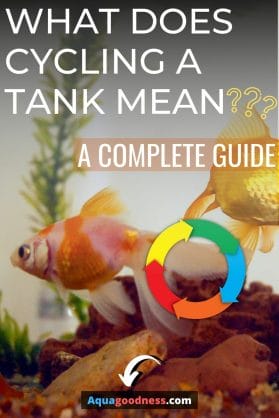
Table of Contents
What does fish tank cycling mean?
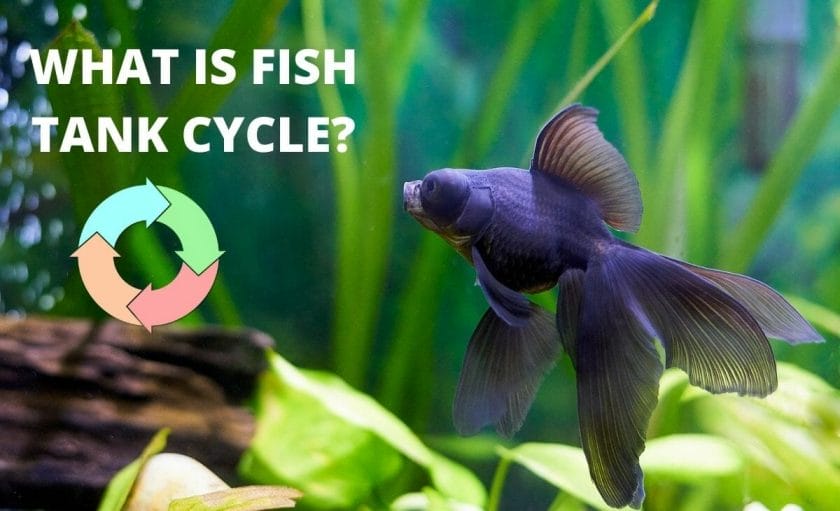
Fish in an aquarium need clean and safe water to survive and grow.
When you keep a fish in an aquarium and feed the fish, the fish will produce waste. This waste breaks down after some time and turns into ammonia.
Besides, the leftover fish food in the fish tank breaks down after some time and produces ammonia in the fish tank.
Now ammonia is harmful to the fish. High ammonia level in fish tank water is deadly for the fish!
To get rid of this ammonia you’ll need to cycle your fish tank.
Cycling a fish tank basically means that you are creating a colony of nitrifying bacteria in your fish tank also known as beneficial bacteria.
This beneficial bacteria will convert the ammonia in your fish tank into nitrites and then convert the nitrites as it appears into nitrates.
As you can see it is basically a conversion cycle done by nitrifying bacteria. That’s why it is called as “nitrogen cycle” or simply “fish tank cycle” in the fishkeeping hobby.
Nitrates are far less harmful to the fish compared to ammonia and nitrite. And depending on the species of fish in your aquarium, it can tolerate nitrate levels as high as 40 PPM (Parts Per Million).
Once the nitrate levels build up in your fish tank, you can do a partial water change to dilute the nitrate in your aquarium and make water safe for the fish.
How frequently you’ll need to do water change depends on the size of your aquarium, the type and size of fish in the aquarium, and the number of fish you have in the aquarium.
Usually, you’ll need to do a water change on a weekly basis if the fish tank is big enough for the fish in your aquarium.
Besides, another way to reduce nitrates from your fish tank is by keeping some live aquarium plants in the fish tank.
Nitrates contain nitrogen which promotes growth in live plants. That’s why live aquarium plants will absorb nitrates from your fish tank and keep the nitrate level under control.
How to cycle a fish tank?
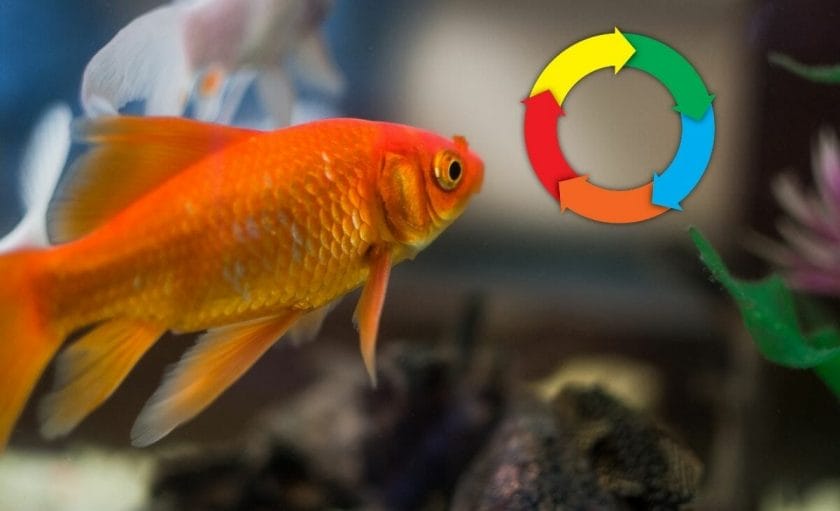
Now that you know what cycling a fish tank means and its importance for creating a healthy environment for your fish, you may be wondering, how can you cycle your fish tank?
Well, this is what we’re going to cover in this section.
But before getting into that let me first tell you what you’ll need to cycle your fish tank.
What you will need to cycle a fish tank?
You’ll need the following things to cycle your fish tank.
Tank
This is the obvious one. But I have to mention it and tell you a few things about choosing the right size of the tank.
Choosing the right size of the tank is important because if you choose a small tank for the fish you’re going to keep in it then it will not be good for the fish because there will not be much space for the fish to move around.
But most importantly, if you put a big fish or the fish that can get pretty big in a small tank then the fish will produce a lot of waste in the tank. Eventually, the waste will produce a lot of ammonia.
High ammonia levels can stress the fish. Besides, the nitrate will build up pretty quickly in such tanks. So you’ll need to do water changes very frequently.
That’s why it is very important to do research about the ideal tank size for the fish you’re going to keep in the tank before getting the tank.
You can get a small fish initially and then upgrade the tank to a bigger tank as the fish grows. But just make sure not to get a too small tank.
Another benefit of getting a larger tank is that it is more forgiving than a smaller one. Because in a small tank if anything went wrong, say – your filter stopped working then the waste can build up pretty quickly and it can stress your fish.
On the other hand, in a larger tank, it will take a while for waste to build up. So in the meantime, you can get a new filter.
Filter
You’ll need a filter to cycle your fish tank. Filter not only cleans the visible impurities from the tank but it is also a great place for beneficial bacteria (the bacteria that cycles the fish tank) to form their colonies.
Besides, a filter keeps water circulating which avoids stagnation in the tank.
And filter also creates water agitation which helps to oxygenates the tank.
Keeping your fish tank well oxygenated is very important because beneficial bacteria are living organisms and they need oxygen to survive in your tank.
If you’re just starting out in the hobby then you should you to go with a hang on the back (HOB) filter. Hob filters are very cheap and effective.
I recommend AquaClear Power Filter. It is a very reliable filter and it comes in different sizes so you can choose according to your tank size.
You can check out its reviews and price at the latest Amazon here.
Dechlorinator
If you are going to use tap water for your fish tank then it is treated with chlorine to remove impurities.
Now chlorine is harmful to beneficial bacteria as well as to fish that’s why you’ll need to dechlorinate your tap water before adding it to your fish tank.
If your fish tank water contains chlorine then the nitrogen cycle will not start in your tank.
You can easily remove chlorine from your fish tank by adding a dechlorinating solution in the water.
I recommended Tetra AquaSafe Plus. This water conditioner is specifically made for fish tanks. You can check its reviews and price at Amazon here.
Ammonia source
To start the nitrogen cycle in your fish tank, you’ll need to add ammonia in the tank.
Now, depending on the method you’re going to use to cycle your fish tank, the ammonia source can vary.
I’m going to tell you about the methods of cycling a fish tank in detail later in the article.
But for now, basically, there are two ways to cycle a fish tank.
1. Fishless cycling– In this method, you don’t use a fish to produce ammonia in the tank. Instead, you can use pure ammonia or fish food. Usually, using pure ammonia solution to seed ammonia in the fish is recommended because it gives you more control of how much ammonia you’re adding. And you’ll know exactly how much ammonia you’ve added in the tank.
On the other hand, if you use fish food to produce ammonia in your tank then it can be a bit iterative process to get the right ammonia levels in your tank.
If you’re going with pure ammonia then I recommend Fritz PRO – Ammonium Chloride. You can check its reviews and price at Amazon here.
2. Fish-in cycling– In this method, you’ll add a hardy fish in to the tank. Eventually, fish waste will produce ammonia in the tank.
Here’re some of my recommended hardy aquarium fish for fish-in cycling:
- Danio
- Platy
- Swordtail
- Gopi
- Molly
- Play ko
- Barbs
Test kit
During the fish tank cycling, you’ll need to regularly test your aquarium water.
You’ll need to test the ammonia, nitrite, and nitrate levels of your tank water to know how your fish tank cycle is going.
Besides, you’ll need to test the pH of the water to make sure it is above 7.
You can easily test all these water parameters using an aquarium test kit.
I recommend API Master Test Kit. You can test all the water parameters I just mentioned using this test kit. This is a liquid-based test it so it is pretty accurate. This test kit might seem a bit expensive but it is going to last you for a long time so it worth it.
You can check its reviews and price at Amazon here.
Heater
Beneficial bacteria thrive between the range of 65° F to 85° F. Below 65° F the growth rate of beneficial bacteria decreases drastically.
So to maintain the ideal temperature you’ll need to add a heater in your cycling aquarium.
I recommend Orlushy Submersible Aquarium Heater. It comes in five sizes so you can choose a heater according to the size of your aquarium.
You can check its sizes, reviews, and latest price at Amazon here.
How to do fishless cycling?

Fishless cycling is a very natural way of cycling a fish tank.
The best part about fishless cycling is, unlike fish-in cycling, you’re not risking the life of your fish.
Fishless cycling (step-by-step process)
- First of all, you’ll need to set up your fish tank. So add dechlorinated water in your fish tank then set up a filter and a heater in your tank.
- Once your fish tank is set up, now you’ll need to add ammonia in your tank. You have two options to add ammonia in your tank. Either you can use pure ammonia or use fish food to produce ammonia in your tank.
- I recommend using an ammonia solution just because it is very easy to work with compared to fish food.
- So if you went with pure ammonia then you’ll need to add the ammonia dose according to the instructions mentioned on the pure ammonia bottle.
- If you went with fish food then you’ll need to add a pinch of fish food in your tank. Then wait for about 24 hours and then check ammonia levels in your tank using a test kit. And make your the ammonia levels are between 2 to 5 PPM (parts per million)
- Once you’ve added ammonia in your tank then you’ll need to check the ammonia levels and nitrite levels in your tank. And make sure that the ammonia is between 2 to 5 ppm. If ammonia drops below 2 ppm then again add ammonia solution or fish food to raise the ammonia level.
- After about 2 weeks you should see some nitrite levels in your tank. If you see some nitrite levels then it is a good sign that your fish tank cycle is moving ahead.
- Again make sure to maintain ammonia levels between 2 to 5 ppm.
- Once you started to see some nitrite levels in your tank then you should start testing your aquarium water for nitrate.
- Then after about two more weeks, you should start to see some nitrate levels in your fish tank.
- The point at which after adding ammonia in your fish tank, after about 24 hours if you see 0 ammonia, 0 nitrite, and some nitrate in the tank at that point you can conclude your fish tank cycle has completed.
Should I Do a Water Change During Fishless Cycling?
How to do fish-in cycling?
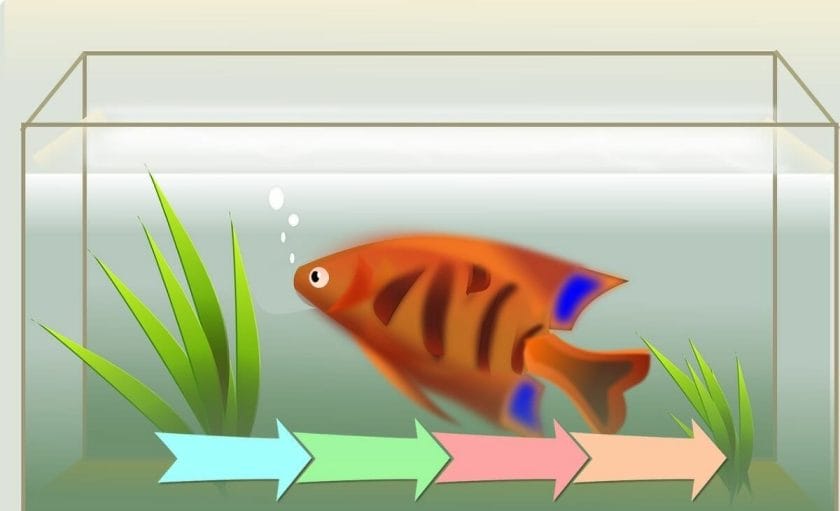
In the fish-in cycling method, you’ll need to add a hardy species of fish in your fish tank from the very beginning.
Fish-in cycling (step-by-step process)
- First of all, you’ll need to set up your fish tank. To do that add dechlorinated water in the tank. Then set up a filter and heater in the tank.
- Now add fish in your tank.
- Once you’ve added the fish then you’ll need to feed the fish. In the beginning, feed the fish very lightly. You should add about a pinch of fish food in your tank every time you feed your fish. And feed your fish a maximum of two times per day. Also after feeding the fish make sure to remove any uneaten food.
- (Optional step) At this point, you can add a bottle of beneficial bacteria to speed up the nitrogen cycle process. Remember, at this stage, your fish tank doesn’t contain any beneficial bacteria to convert deadly ammonia into less harmful nitrate. So if you add a bottle of beneficial bacteria then it will take care of any ammonia spick and save your fish. I recommend FritzZyme 7 Nitrifying Bacteria. A lot of people had good experiences with this beneficial bacteria bottle. You can check its review and price at Amazon here
- Now you’ll need to test your aquarium water on a daily basis for ammonia and nitrite.
- If you see even slight ammonia levels in your tank (up to 0.2 ppm) then do a partial water change to dilute the ammonia.
- After about two to three weeks you should see some nitrite levels in your fish tank. At this stage, your nitrogen cycle has started.
- Again if you see some ammonia or nitrite levels (even 0.2 ppm) then you should do a partial water change to dilute it.
- Once you started to see some nitrite levels in your tank then you should start testing your aquarium water for nitrate.
- After about two to three weeks, you should see some nitrate levels in your fish tank.
- The point at which you started to see 0 ammonia, 0 nitrite, and some nitrate in your fish tank for seven to eight consecutive days then you can conclude that your fish tank cycle has completed.
Note: Though nitrates are less harmful to fish, high levels of nitrates are harmful to fish. Depending on the species of fish, fish can tolerate nitrate levels as high as 40 ppm. However, I recommend you keep nitrate levels below 20 ppm. If you see nitrate levels above 20 ppm then do a partial water change to reduce the nitrate levels.
Tips to cycle your fish tank fast
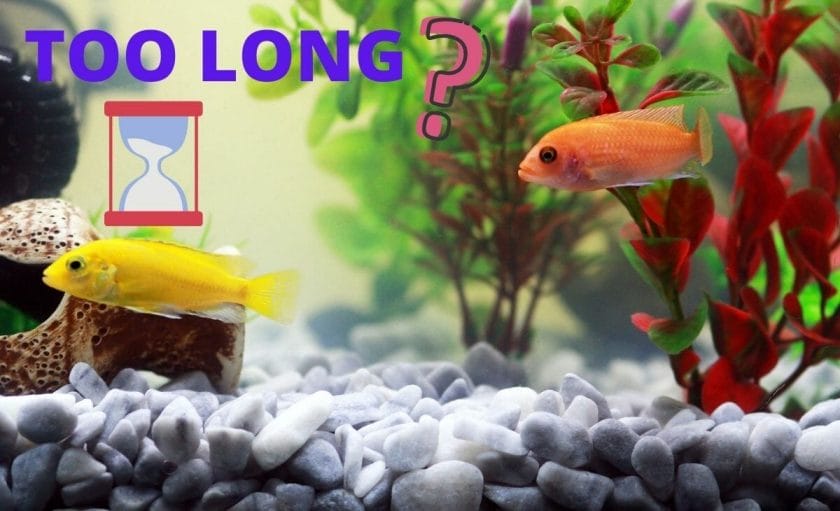
When you are cycling your fish tank for the first time, there are a few mistakes you may make unknowingly that can slow down or stop the nitrogen cycle.
If you avoid these mistakes then you’ll be able to cycle your fish tank fast.
1. The fish tank contains more than 5 ppm of ammonia
You’ll need to add ammonia in your fish tank to start the nitrogen cycle. The reason being ammonia is food for the nitrifying or beneficial bacteria, the bacteria that you want in your fish tank to cycle your tank.
However, too much ammonia (more than 5 ppm) is toxic for the beneficial bacteria. So if your fish tank contains more than 5 ppm ammonia, then the beneficial bacteria will not grow in your tank. This can slow down the nitrogen cycle in your tank. Worst, too much ammonia can even stop the nitrogen cycle.
So if you noticed that your fish tank contains ammonia more than 5 ppm then you should immediately do a partial water change to reduce the ammonia levels.
2. The fish tank contains pH below 7 ppm
People pay very close attention and test the ammonia, nitrite, and nitrate levels in their fish tank while cycling the tank.
However, most people completely overlook the pH levels in their tank.
Paying attention to the pH in your aquarium is very important because pH lower than 7 ppm can slow down or stop the nitrogen cycle in your fish tank.
That’s why you should regularly test the pH in your fish tank. And if you noticed pH below 7 ppm then doing a partial water change of about 20% of the aquarium water can raise the pH in your tank.
3. Fish tank water temperature below 65° Fahrenheit
The beneficial bacteria that cycles your fish tank thrives between the temperature of 65° Fahrenheit to 85° Fahrenheit.
If the temperature in your fish tank drops below 65° Fahrenheit then it slows down the growth rate of beneficial bacteria.
To avoid the temperature dropping below 65° Fahrenheit, you should install an aquarium heater in your tank.
I recommend Orlushy Submersible Aquarium Heater. It comes in five sizes so you can choose a heater according to the size of your aquarium.
You can check its sizes, reviews, and latest price at Amazon here.
Besides, you should also install an aquarium thermometer. It will continuously monitor the temperature of your tank so you can make sure that the temperature in your fish tank is in the ideal range.
There are different types of aquarium thermometers available in the market. But this digital thermometer is very accurate and it looks very cool on a fish tank.
You can check its reviews and price at Amazon here.
How to cycle your fish tank instantly?

Cycling a fish tank can take a while. It can take anywhere between four to eight weeks to cycle a fish tank.
I know it can be very frustrating to wait for one to two months just to cycle the fish tank.
But you don’t have to wait that long to cycle your fish tank. There are ways to cycle your fish tank instantly.
1. Add a filter or filter media from a cycled aquarium
The beneficial bacteria form their colonies in the filter, specifically, on the sponge filter of the aquarium filter.
So if you just pull out the filter or filter media from an already cycled aquarium and put it in your new aquarium then your new fish tank will have a lot of beneficial bacteria.
Now, these beneficial bacteria will convert the harmful ammonia into nitrite and then into less harmful nitrate.
In this way, you can cycle your fish tank instantly, just by adding a filter or filter media from a cycled aquarium.
Where can I get the filter or filter media from a cycled aquarium?
I’m assuming that you don’t have a cycled aquarium. So in this case, you may be wondering where you could get the filter or filter media of a cycled aquarium.
Well, there are a few places you can reach out to get a filter or filter media from a cycled aquarium.
1. Local fish store
Your local fish store will have a lot of cycled aquariums. If you get your livestock from the store then they’ll be more than happy to give you filter media from one of their cycled aquariums.
2. Ask a friend
If you have a fishkeeper friend then you can just ask him to give you the filter media from his cycled aquarium.
He/she will be more than happy to give you the media if he wanted to change it anyway.
3. Local fish clubs
There are a lot of local fish clubs in every country. So you’ll need to find the local fish club in your area and ask club members to give you the filter media from their established/cycled aquarium.
2 Things to keep in mind while getting the filter media
Cycling a fish tank instantly using a filter or filter media from a cycled aquarium is a very reliable way to cycle your fish tank.
But there are a few things you’ll need to keep in mind if you’re going to use this method.
1. Don’t let the filter media dry out
The beneficial bacteria on the filter media need dissolved oxygen to survive. So when you are getting filter media to add to your new tank, make sure not to let it dry out.
You can add the filter media in a polybag containing water from the cycled aquarium to carry it with you.
2. Get the filter media only from a trusted source.
When you are adding the filter media from another tank in your tank, you’re not only adding the beneficial bacteria but also any harmful bacteria or viruses if the cycled tank has any.
That’s why it is very important to get the filter media only from a trusted source.
2. Pour down the beneficial bacteria bottles in your new tank
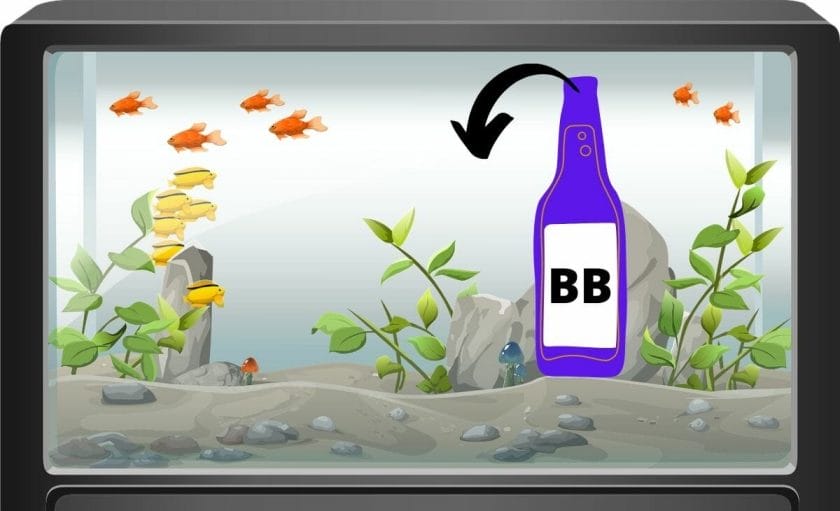
There are several brands that sell beneficial bacteria in bottles. If you pour down the bottles in your tank then your tank will have the beneficial bacteria and your new tank will be cycled instantly!
Now the problem with these bottles of beneficial bacteria is that, sometimes, by the time you add them to your tank the beneficial bacteria are dead. And dead beneficial bacteria are not going to cycle your tank.
I recommend FritzZyme 7 Nitrifying Bacteria. A lot of people had a good experience with this beneficial bacteria bottle. You can check its review and price at Amazon here
Conclusion
Cycling a fish tank means creating a natural-automatic filtration system in your fish tank. Cycling a new fish tank is very important to create a clean environment for the fish.
If you didn’t cycle your tank before adding fish then toxic impurities will build up in the tank and this can be deadly for the fish.
You can use any of the ways I’ve mentioned in this article to cycle your fish tank.
I hope you found this article helpful.
If you do, please share it with anyone who’s just starting or thinking about starting their first aquarium.
Happy fishkeeping!
Related article:





